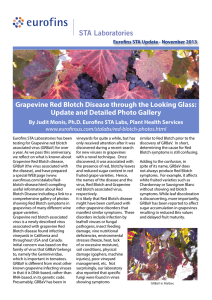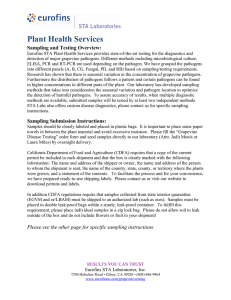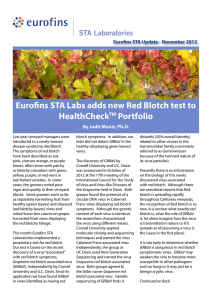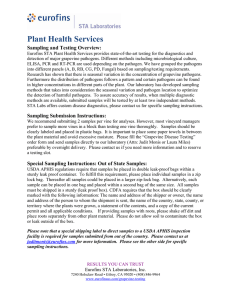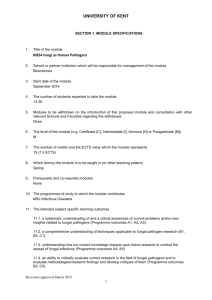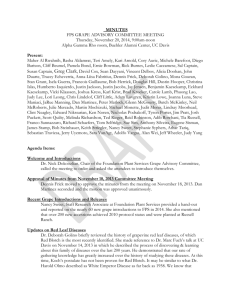Red Blotch Symptoms in California Vineyards By Judit Monis, Ph. D
advertisement
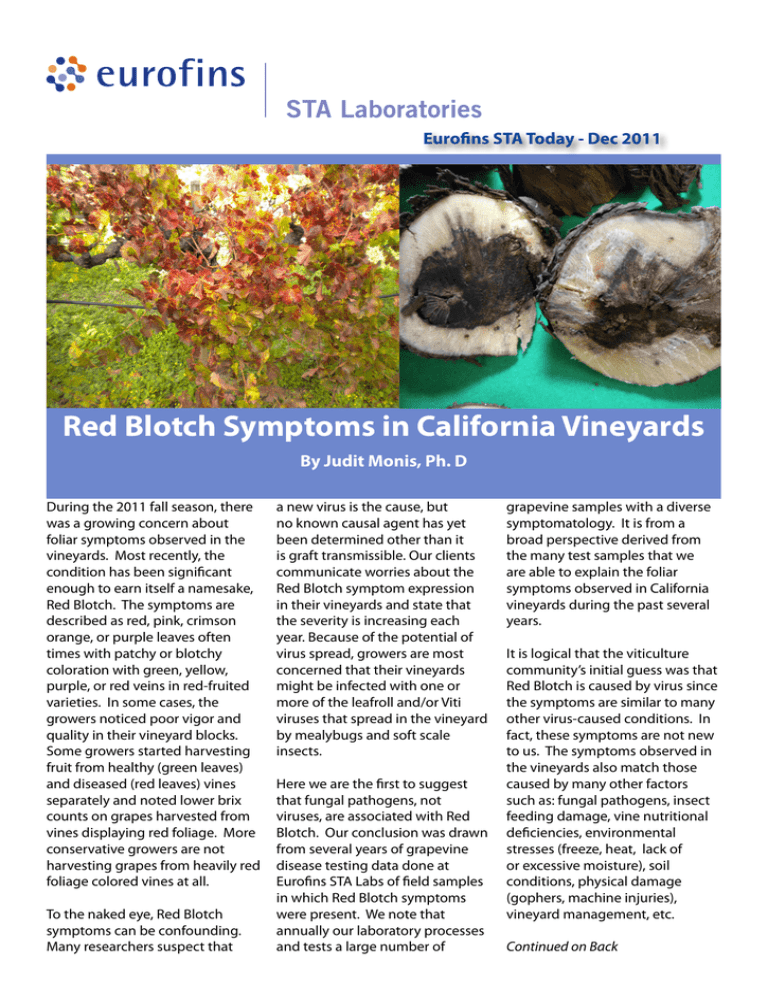
Eurofins STA Today - Dec 2011 Red Blotch Symptoms in California Vineyards By Judit Monis, Ph. D During the 2011 fall season, there was a growing concern about foliar symptoms observed in the vineyards. Most recently, the condition has been significant enough to earn itself a namesake, Red Blotch. The symptoms are described as red, pink, crimson orange, or purple leaves often times with patchy or blotchy coloration with green, yellow, purple, or red veins in red-fruited varieties. In some cases, the growers noticed poor vigor and quality in their vineyard blocks. Some growers started harvesting fruit from healthy (green leaves) and diseased (red leaves) vines separately and noted lower brix counts on grapes harvested from vines displaying red foliage. More conservative growers are not harvesting grapes from heavily red foliage colored vines at all. To the naked eye, Red Blotch symptoms can be confounding. Many researchers suspect that a new virus is the cause, but no known causal agent has yet been determined other than it is graft transmissible. Our clients communicate worries about the Red Blotch symptom expression in their vineyards and state that the severity is increasing each year. Because of the potential of virus spread, growers are most concerned that their vineyards might be infected with one or more of the leafroll and/or Viti viruses that spread in the vineyard by mealybugs and soft scale insects. Here we are the first to suggest that fungal pathogens, not viruses, are associated with Red Blotch. Our conclusion was drawn from several years of grapevine disease testing data done at Eurofins STA Labs of field samples in which Red Blotch symptoms were present. We note that annually our laboratory processes and tests a large number of grapevine samples with a diverse symptomatology. It is from a broad perspective derived from the many test samples that we are able to explain the foliar symptoms observed in California vineyards during the past several years. It is logical that the viticulture community’s initial guess was that Red Blotch is caused by virus since the symptoms are similar to many other virus-caused conditions. In fact, these symptoms are not new to us. The symptoms observed in the vineyards also match those caused by many other factors such as: fungal pathogens, insect feeding damage, vine nutritional deficiencies, environmental stresses (freeze, heat, lack of or excessive moisture), soil conditions, physical damage (gophers, machine injuries), vineyard management, etc. Continued on Back Red Blotch Symptoms in California Vineyards Continued At Eurofins STA Labs when one of our seasonal virus test panels (in particular, HealthCheck™ Panels A) does not detect virus in a clearly symptomatic vine sample, we recommend more exhaustive testing. This includes assuring that representative samples are tested to increase the probability of finding the causal agent(s) as well as testing for other causes such as fungal or bacterial pathogens. To obtain the most complete results samples should consist of portions of the main root, trunkincluding the graft union, and a diverse collection of cane cuttings located at different locations of the vine. We also recommend testing a larger number of samples (generally, a minimum of five samples for HealthCheck™ Panel A). In many cases, a more extensive sampling may yield different results. But most important is to test for pathogenic fungi, especially if the vines show signs of fungal infection (wood discoloration, streaking, dieback, canker, dead arm, unilateral decline, severe wood rotting, etc.) where disease symptoms are seen but virus remains undetected. To specifically survey and identify many grapevine fungal pathogens our HealthCheck™ Fungal Panel was developed. The panel uses traditional microbiological diagnostic methods with the aid of a microscope that can be complemented by molecular techniques developed at Eurofins STA for the rapid and accurate identification of pathogens. Over the last three years Eurofins STA Labs tested many different batches of samples from a large variety of vineyards in California that displayed the red leaves, often times very similar to leafroll virus and the Red Blotch symptoms. On occasion, when virus was not found, fungal tests were recommended and carried out. Without exception, our work resulted in the isolation of pathogenic fungi from each sample. We conclude from the universal fungal presence that the Red Blotch symptoms observed in the vineyards are caused by fungal and not viral infection. The data indicates the presence of, not one, but a complex of fungal pathogens that are known to affect grapevine and other crops. The data supporting that fungal and not viral pathogens are associated with the Red Blotch will be presented to the research community at the International Grapevine Trunk Disease Meeting (IWGTD) to be held in Valencia (Spain) in the summer of 2012. The assessment of the health status of a vineyard is a crucial step to managing disease in the vineyard. If test results for nutrition or virus testing do not explain the cause for symptoms observed in the vineyard, do not sigh in relief- further testing will help pinpoint the culprit. Please call our lab with questions related to general vineyard health or specifically about Red Blotch symptoms. STA Laboratories Colorado Laboratory 1821 Vista View Drive Longmont, Colorado 80504 (303) 651-6417 Gilroy Laboratory 7240 Holsclaw Rd. Gilroy, CA 95020 (408) 846-9964 www.eurofinsus.com/stalabs stalabs@eurofinsus.com
